Evening Walk
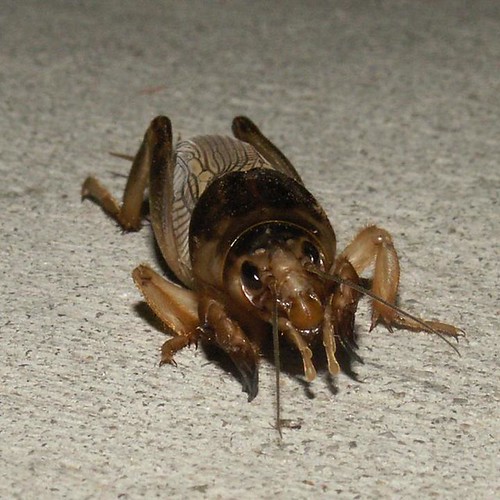
I've Grown Accustomed To His Face
(with apologies to Alan Jay Lerner)
I've grown accustomed to his face.
The way he scuttles on the walk.
I've grown accustomed to the frown that
I make when he chows down
On seedlings, on grass.
He digs with such class.
And when he rubs his little wings
It seems to me he wants to talk.
I was afraid of going buggy but my camera showed me how,
In these days of hot and muggy I can find his charm --
And now
I've grown accustomed to his smile;
Accustomed to his pose;
Accustomed to his face.
(To the tune of "I've Grown Accustomed To Her Face,"
from the musical My Fair Lady.)
(with apologies to Alan Jay Lerner)
I've grown accustomed to his face.
The way he scuttles on the walk.
I've grown accustomed to the frown that
I make when he chows down
On seedlings, on grass.
He digs with such class.
And when he rubs his little wings
It seems to me he wants to talk.
I was afraid of going buggy but my camera showed me how,
In these days of hot and muggy I can find his charm --
And now
I've grown accustomed to his smile;
Accustomed to his pose;
Accustomed to his face.
(To the tune of "I've Grown Accustomed To Her Face,"
from the musical My Fair Lady.)
This is a male tawny mole cricket (Scapteriscus vicinus, Family Gryllotalpidae) -- once again spotted by Mary (a.k.a. my Mole Cricket Finder), this time on the sidewalk of our local strip mall. Both forelegs show up clearly in this shot, and the fact that the tibial dactyls (essentially the "fingers") are close together suggests vicinus. A side view of this same guy also has a good view of the dactyls. More on mole crickets is in my entry Peanuts and Coffee.
My buddy here showed up near the end of our walk, which was originally supposed to be just a brief jaunt around the block, so that Mary could show me a tower of jasmine....
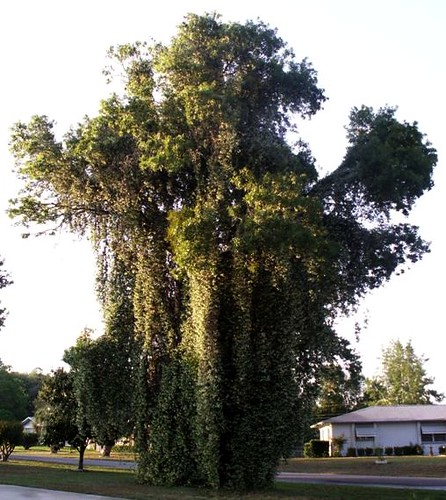
When Mary went out jogging a few mornings ago she came back with news of this Star Jasmine dripping from one of our neighbor's trees. Trachelospermum jasminoides, Family Apocynaceae (dogbane family). Also called Confederate jasmine. Says Floridata.com, "This beautiful and energetic evergreen vine creates a special scene all through the year as it clambers 40 ft (12 m) up tree trunks using its holdfast roots to pull itself almost to the top. During April and May the plant goes two-tone as it flushes light green with new growth. Shortly thereafter the scene transforms again when the delicate 1 in (2.5 cm) white pinwheel flowers delicately breathe enchanting fragrances into the spring air."
This plant, however, is neither a "true" jasmine nor native to the American south (despite the name "Confederate jasmine") or to the U.S. at all. "It comes from China but has been a popular garden plant in Europe and the U.S. for centuries," says Floridata. It's called a jasmine because of its heady, jasmine-like fragrance.
Floridata adds, "Do not grow Confederate jasmine on trees that are near structures. Any vine (wisteria, Virginia creepers, English ivy, etc.) can make trees top heavy and subject to falling in high winds. If you grow this or any vine on trees, monitor growth and trim stems if it becomes too massive."
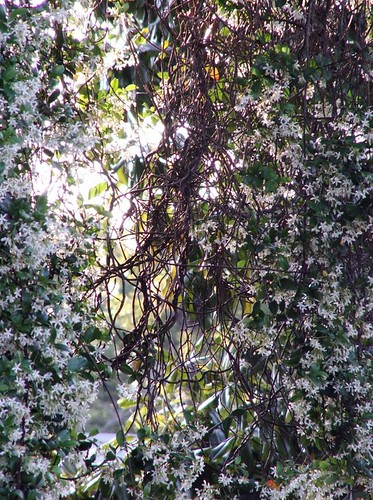
Zooming in, I got this shot of a jasmine curtain.
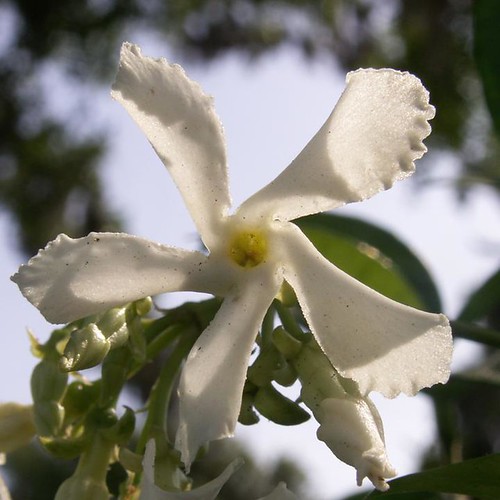
This individual flower doesn't come from the jasmine in our neighborhood, but from a low clump of the plants at the Crystal River Mall, one of the major shopping areas in the county. These plantings are dotted throughout the parking lot and remain low to the ground. We'd been at the mall the day before we took this walk.
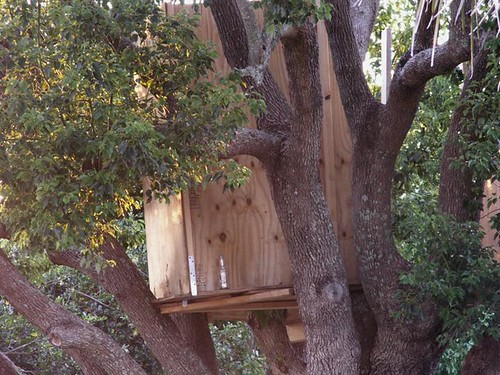
In our evening jaunt, we took streets we haven't fully explored yet, and found this charming treehouse in a neighbor's yard.
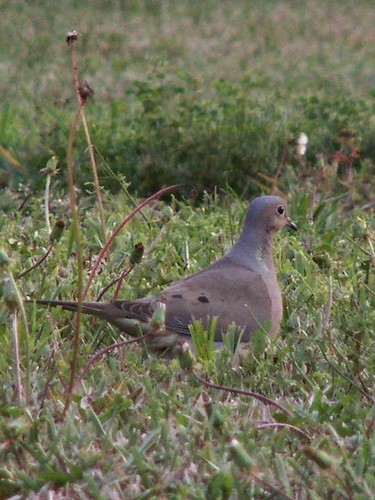
Despite the fact that we hear these mourning doves all the time (Zenaida macroura, Family Columbidae) I didn't get a shot of one until now. Ranges from southeast Alaska to southern Canada to Panama, according to the Peterson Field Guide to the Birds of Eastern and Central North America. I have yet to photograph one in flight with its marvelous pointed tail spead out.
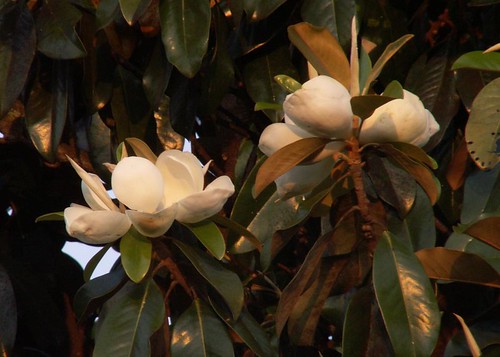
The magnolias are blooming again (Southern Magnolia, Magnolia grandiflora). Our Audubon Society Field Guide to Florida says these trees grow to be 100 feet tall, and I can believe it. Last year I had taken shots of their autumn seed pods, including a fallen pod.
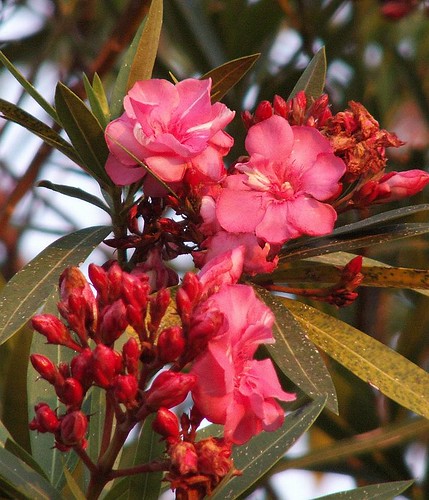
I'm still trying to ID this plant, which I haven't been able to find in our field guides. Mary thought it might be an osier, but not all the details seem to match.
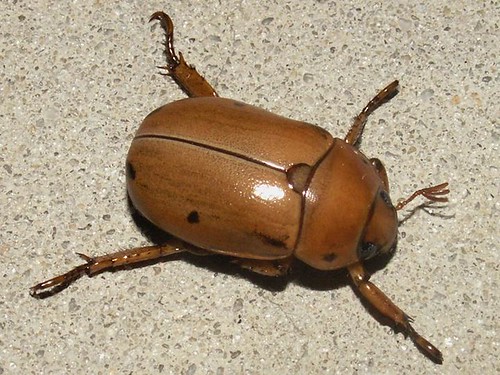
Not far from where Mary saw the mole cricket I had spotted this Grapevine Beetle (Pelidnota punctata, Family Scarabaeidae (Scarab Beetles)). According to Bugguide.Net, this genus was named by MacLeay in 1817. Pelidnota is from the Greek pelion, livid (meaning discolored: ashen, gray, or lead-colored--or black-and-blue), plus the Greek suffix -ota, made. The Audubon Society Field Guide to North American Insects and Spiders gives its range as the eastern half of the United States. "Adult feeds on leaves and fruits of wild and cultivated grapes. Larva eats decaying wood in tree stumps....Grapevine Beetles fly rapidly, usually in curves."
This one had been sitting pretty still on the sidewalk, luckily for me. Getting my camera to focus in low light was a bit of a challenge. Mary attempted to move it to a better-lit area, but it took flight first.
Scarabs range from beneficial recyclers of dung, carrion, and decaying vegetable matter, to agricultural pests, according to the Audubon. "They have distinctive, clubbed antennae composed of leaflike plates, called lamellae, that can be drawn into a compact ball or fanned out to sense odors." Here you can see one of those antennae near its left eye, with the lamellae fanned out --probably to sniff the photographer.











3 Comments:
He is surprisingly cute -:)
You've definitely captured something in the eyes. Quite bewitching.
Have you had one bite you yet? I got quite a nip not too long ago.
Great photograph, by the way!
bye!
tf23
Your unidentified plant is an oleander, from what I can tell. All parts of it are poisonous, but has beautiful color and shape.
Post a Comment
<< Home